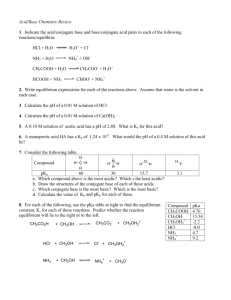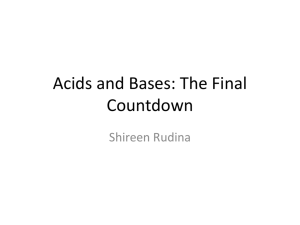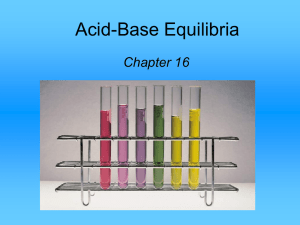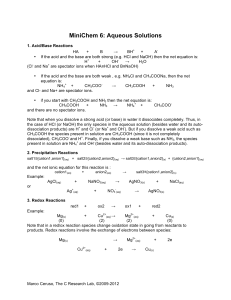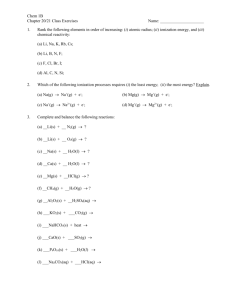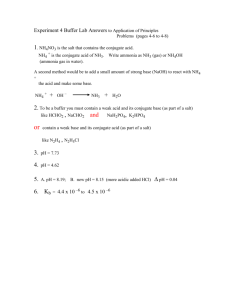Acid-Base Equilibria and Solubility Equilibria
advertisement
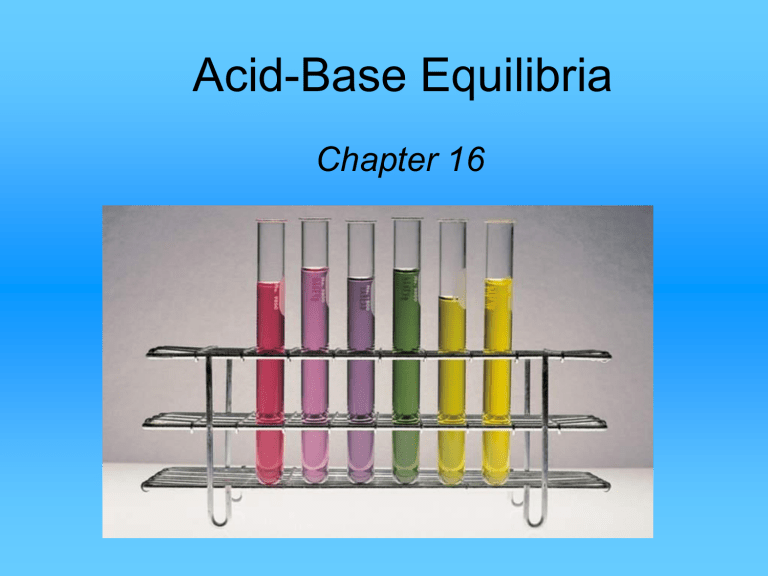
Acid-Base Equilibria Chapter 16 The __________________is the shift in equilibrium caused by the addition of a compound having an __________in common with the______________ substance. The presence of a common ion _____________the ionization of a ________acid or a __________base. Consider mixture of CH3COONa (_______electrolyte) and CH3COOH (_______ acid). CH3COONa (s) Na+ (aq) +) CH3COOH (aq) H+ (aq) +) common ion 16.2 A ________________is a solution of: 1. A weak ______or a weak _______and 2. The _________of the weak acid or weak base Both must be present! A ____________has the ability to _________changes in ___upon the addition of small amounts of either _______or __________. Consider an equal molar mixture of CH3COOH and CH3COONa CH3COOH (aq) H+ (aq) + CH3COO- (aq) Adding more _______creates a shift left IF enough _________ions are present 16.3 Which of the following are buffer systems? (a) KF/HF (b) KCl/HCl, (c) Na2CO3/NaHCO3 (a) KF is a weak acid and F- is its conjugate base _______________ (b) HCl is a strong acid _______________ (c) CO32- is a weak base and HCO3- is it conjugate acid _______________ 16.3 What is the pH of a solution containing 0.30 M HCOOH and 0.52 M HCOOK? Mixture of weak acid and conjugate base! HCOOH (aq) H+ (aq) + HCOO- (aq) Initial (M) Change (M) Equilibrium (M) Ka for HCOOH = 1.8 x 10 -4 16.2 What is the pH of a solution containing 0.30 M HCOOH and 0.52 M HCOOK? Mixture of weak acid and conjugate base! HCOOH (aq) H+ (aq) + HCOO- (aq) Initial (M) Change (M) Equilibrium (M) Common ion effect 16.2 HCl HCl + CH3COO- H+ + ClCH3COOH + Cl- 16.3 Calculate the pH of the 0.30 M NH3/0.36 M NH4Cl buffer system. What is the pH after the addition of 20.0 mL of 0.050 M NaOH to 80.0 mL of the buffer solution? Initial Change End 16.3 Calculate the pH of the 0.30 M NH3/0.36 M NH4Cl buffer system. What is the pH after the addition of 20.0 mL of 0.050 M NaOH to 80.0 mL of the buffer solution? final volume = 80.0 mL + 20.0 mL = 100 mL start (M) end (M) pH = 9.20 16.3 Calculate the pH of the 0.30 M NH3/0.36 M NH4Cl buffer system. What is the pH after the addition of 20.0 mL of 0.050 M NaOH to 80.0 mL of the buffer solution? [ [ [ start (M) end (M) = 16.3 Chemistry In Action: Maintaining the pH of Blood 16.3 Titrations In a ____________a solution of accurately known _____________is added gradually added to another solution of __________concentration until the chemical reaction between the two solutions is complete. ___________________– the point at which the reaction is complete ___________– substance that changes color at the ________ (hopefully close to the equivalence point) Slowly add base to unknown acid UNTIL The indicator changes color (________) 4.7 Strong Acid-Strong Base Titrations NaOH (aq) + HCl (aq) OH- (aq) + H+ (aq) H2O (l) + NaCl (aq) H2O (l) 100% ionization! ___________ _ 16.4 _________Acid-________ Base Titrations CH3COOH (aq) + NaOH (aq) CH3COOH (aq) + OH- (aq) CH3COONa (aq) + H2O (l) CH3COO- (aq) + H2O (l) At equivalence point (pH ______ 7): CH3COO- (aq) + H2O (l) OH- (aq) + CH3COOH (aq) 16.4 _________Acid-__________ Base Titrations HCl (aq) + NH3 (aq) H+ (aq) + NH3 (aq) NH4Cl (aq) NH4Cl (aq) At equivalence point (pH _____7): NH4+ (aq) + H2O (l) NH3 (aq) + H+ (aq) 16.4 Acid-Base Indicators 16.5 The titration curve of a strong acid with a strong base. 16.5 Which indicator(s) would you use for a titration of HNO2 with KOH ? _______acid titrated with _________base. At equivalence point, will have __________________acid. At equivalence point, pH _____ 7 Use __________or__________________ 16.5 Finding the Equivalence Point (calculation method) • ________Acid vs. ________Base – ________% ionized! pH ____No__________! • ________Acid vs. _______ Base – ______is____________; Need ____for conjugate ________equilibrium • _________Acid vs. ________Base – Base is________________; Need ____for conjugate ________equilibrium • _________ Acid vs. ______ Base – Depends on the ______of both; could be conjugate______, conjugate ______, or pH ___ Exactly 100 mL of 0.10 M HNO2 are titrated with 100 mL of a 0.10 M NaOH solution. What is the pH at the equivalence point ? start (moles) HNO2 (aq) + OH- (aq) NO2- (aq) + H2O (l) end (moles) Final volume = 200 mL NO2- (aq) + H2O (l) Initial (M) Change (M) Equilibrium (M) Kb = = = OH- (aq) + HNO2 (aq) _____________Ion Equilibria and Solubility A __________is an ion containing a central metal cation bonded to one or more molecules or ions. Co2+ (aq) + 4Cl- (aq) Co(H2O)2+ 6 CoCl42- (aq) CoCl24 16.10 16.10 Complex Ion Formation • These are usually formed from a transition metal surrounded by ligands (polar molecules or negative ions). • As a "rule of thumb" you place twice the number of ligands around an ion as the charge on the ion... example: the dark blue Cu(NH3)42+ (ammonia is used as a test for Cu2+ ions), and Ag(NH3)2+. • Memorize the common ligands. Common Ligands Ligands Names used in the ion H2O NH3 aqua ammine OHClBrCNSCN- hydroxy chloro bromo cyano thiocyanato (bonded through sulphur) isothiocyanato (bonded through nitrogen) Names • Names: ligand first, then cation Examples: – tetraamminecopper(II) ion: Cu(NH3)42+ – diamminesilver(I) ion: Ag(NH3)2+. – tetrahydroxyzinc(II) ion: Zn(OH)4 2- • The charge is the sum of the parts (2+) + 4(-1)= -2. When Complexes Form • Aluminum also forms complex ions as do some post transitions metals. Ex: Al(H2O)63+ • Transitional metals, such as Iron, Zinc and Chromium, can form complex ions. • The odd complex ion, FeSCN2+, shows up once in a while • Acid-base reactions may change NH3 into NH4+ (or vice versa) which will alter its ability to act as a ligand. • Visually, a precipitate may go back into solution as a complex ion is formed. For example, Cu2+ + a little NH4OH will form the light blue precipitate, Cu(OH)2. With excess ammonia, the complex, Cu(NH3)42+, forms. • Keywords such as "excess" and "concentrated" of any solution may indicate complex ions. AgNO3 + HCl forms the white precipitate, AgCl. With excess, concentrated HCl, the complex ion, AgCl2-, forms and the solution clears. Coordination Number • Total number of bonds from the ligands to the metal atom. • Coordination numbers generally range between 2 and 12, with 4 (tetracoordinate) and 6 (hexacoordinate) being the most common. Some Coordination Complexes molecular formula Lewis base/ligand Lewis acid donor atom coordination number Ag(NH3)2+ NH3 Ag+ N 2 [Zn(CN)4]2- CN- Zn2+ C 4 [Ni(CN)4]2- CN- Ni2+ C 4 [PtCl6] 2- Cl- Pt4+ Cl 6 Ni2+ N 6 [Ni(NH3)6]2+ NH3
